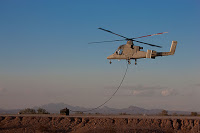A K-MAX unmanned helicopter crashed June 5 in Afghanistan while resupplying Marines.
The crash occurred at a landing zone just northeast of Camp Leatherneck while in the final stages of delivering cargo, according to Marine officials in Afghanistan.
 An investigation is now underway to
determine the cause of the crash, but no injuries occurred as a result
of the mishap, said Capt. Matthew Beers, a 2nd Marine Aircraft Wing
(Forward) public affairs officer.
An investigation is now underway to
determine the cause of the crash, but no injuries occurred as a result
of the mishap, said Capt. Matthew Beers, a 2nd Marine Aircraft Wing
(Forward) public affairs officer.
While Marine officials did not release a cause for the crash, Beers ruled out pilot error, saying the aircraft was in autonomous mode at the time it went down. It was delivering cargo to a predetermined location without the input of a UAV pilot.
The K-MAX is capable of being flown by a pilot aboard or remotely, or it can execute entire missions autonomously if given a predetermined destination. The Marine Corps, which has been using the helicopter in Afghanistan since November 2011, has used it exclusively as an unmanned platform for resupply missions. It has been operated in theater by Lockheed Martin contractors and Marines.
The helicopter, originally produced as a manned aircraft for logging in the northwestern United States by Kaman Aerospace, was retrofitted for unmanned use under a joint effort with Lockheed Martin. The helicopter uses a unique counter rotating rotar design that negates the need for a tail rotor.
It can deliver about 6,000 pounds of gear, water, food and ammunition, and has proven a workhorse that Marine leaders hope will reduce reliance on vulnerable and expensive ground convoys.
The crash occurred at a landing zone just northeast of Camp Leatherneck while in the final stages of delivering cargo, according to Marine officials in Afghanistan.
 An investigation is now underway to
determine the cause of the crash, but no injuries occurred as a result
of the mishap, said Capt. Matthew Beers, a 2nd Marine Aircraft Wing
(Forward) public affairs officer.
An investigation is now underway to
determine the cause of the crash, but no injuries occurred as a result
of the mishap, said Capt. Matthew Beers, a 2nd Marine Aircraft Wing
(Forward) public affairs officer.While Marine officials did not release a cause for the crash, Beers ruled out pilot error, saying the aircraft was in autonomous mode at the time it went down. It was delivering cargo to a predetermined location without the input of a UAV pilot.
The K-MAX is capable of being flown by a pilot aboard or remotely, or it can execute entire missions autonomously if given a predetermined destination. The Marine Corps, which has been using the helicopter in Afghanistan since November 2011, has used it exclusively as an unmanned platform for resupply missions. It has been operated in theater by Lockheed Martin contractors and Marines.
The helicopter, originally produced as a manned aircraft for logging in the northwestern United States by Kaman Aerospace, was retrofitted for unmanned use under a joint effort with Lockheed Martin. The helicopter uses a unique counter rotating rotar design that negates the need for a tail rotor.
It can deliver about 6,000 pounds of gear, water, food and ammunition, and has proven a workhorse that Marine leaders hope will reduce reliance on vulnerable and expensive ground convoys.
No comments:
Post a Comment